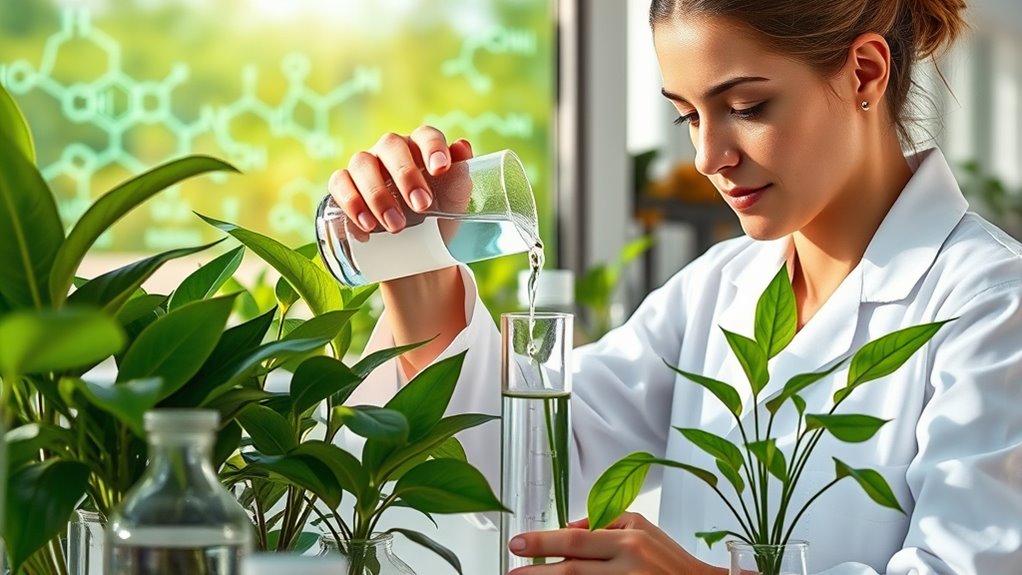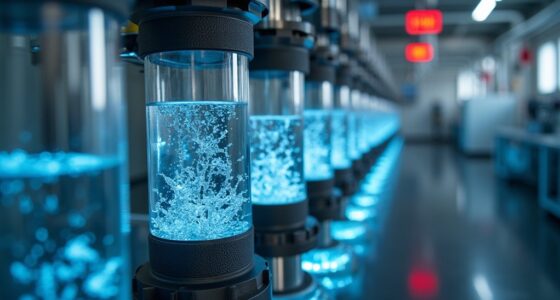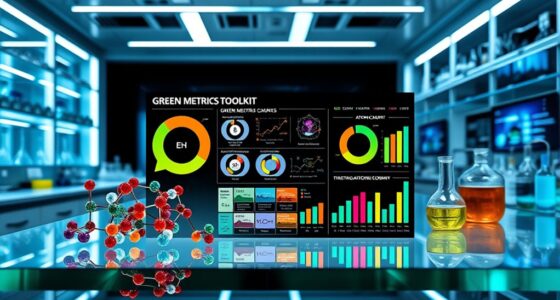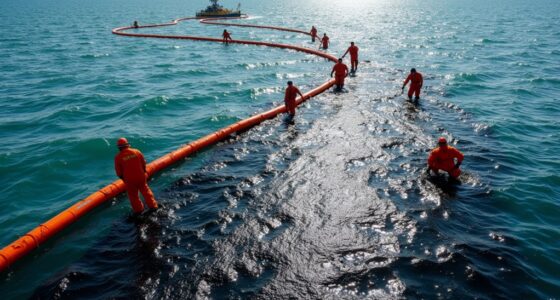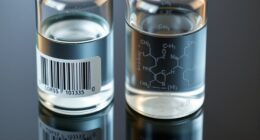Green chemistry focuses on designing processes that reduce waste, use safer materials, and improve efficiency through principles like waste prevention, atom economy, and catalysis. It emphasizes safer solvents, renewable feedstocks, and products that degrade naturally. Techniques like continuous flow, microwave, and photochemistry boost sustainability. If you want to discover practical examples of these principles in action and how they can transform chemical processes, keep exploring to learn more.
Key Takeaways
- Green chemistry focuses on designing processes that minimize waste and maximize atom economy to reduce environmental impact.
- It promotes using safer chemicals, solvents, and process conditions, including continuous flow and alternative energy techniques.
- Utilizing renewable feedstocks and avoiding unnecessary derivatives streamline synthesis and lower hazardous waste.
- Catalysts enhance reaction efficiency, selectivity, and recyclability, supporting sustainable and cleaner production methods.
- Designing products for degradation and pollution prevention ensures environmentally friendly disposal and reduces persistence.
Prevention of Waste
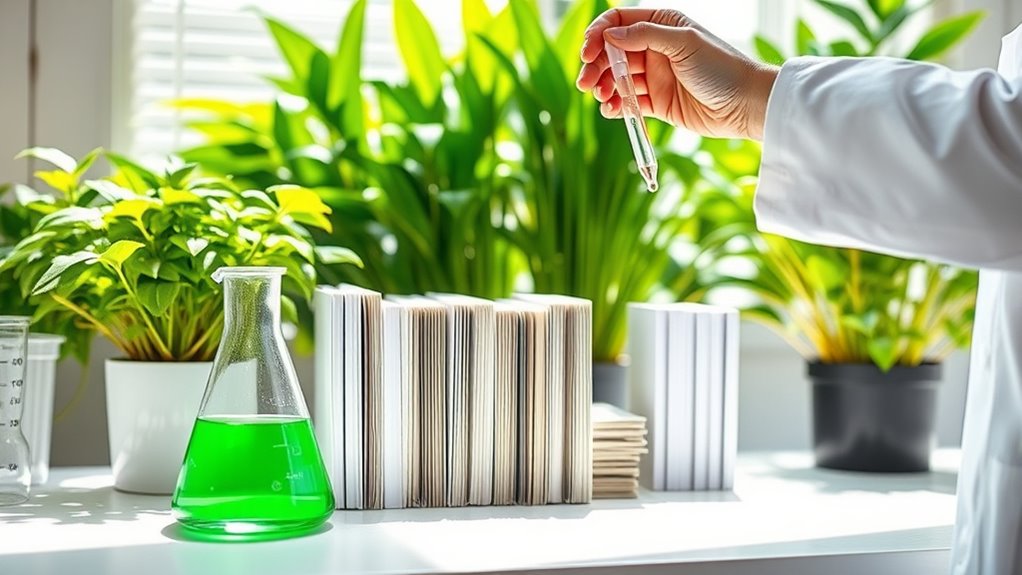
Preventing waste is a fundamental goal in green chemistry because it addresses environmental and economic concerns directly at the source. You should focus on designing chemical processes that minimize or eliminate waste creation from the start, rather than relying on cleanup later. This approach reduces environmental impact by cutting down on hazardous byproducts and lowers costs by avoiding expensive remediation. To achieve this, plan your processes carefully, selecting reaction conditions and materials that produce fewer byproducts. Use safer solvents and incorporate recycling and reuse strategies whenever possible. Keep in mind that waste prevention benefits the entire life cycle of chemicals, from production to disposal. It is preferable to prevent waste formation rather than treating or cleaning it up afterward. Incorporating high-quality process design techniques can further optimize resource utilization and minimize waste. Although implementing these strategies can be complex and require upfront investment, the long-term advantages for both the environment and your budget are significant.
Atom Economy

Atom economy is a key concept in green chemistry that measures how efficiently a chemical reaction incorporates atoms from its reactants into the desired product. It’s calculated by dividing the molecular mass of the desired product by the total molecular mass of all reactants, then multiplying by 100%. Achieving 100% atom economy means all atoms from reactants are in the final product, minimizing waste. This metric is particularly important because it directly relates to reducing environmental impact and resource consumption. Unlike reaction yield, high yield doesn’t guarantee good atom economy if byproducts form. Improving atom economy reduces molecular waste, cuts disposal costs, and promotes sustainable resource use. Reactions like Wittig or Suzuki often have low atom economy due to wasteful reagents. Focusing on atom economy helps you design cleaner, more efficient syntheses that align with green chemistry goals. Enhancing atom economy also supports sustainability by minimizing the need for extensive waste management and reducing the ecological footprint of chemical manufacturing.
Less Hazardous Chemical Syntheses

To promote safer chemical syntheses, scientists focus on reducing hazards associated with raw materials, reaction processes, and waste. You can choose safer raw materials, like using N-methylformamide instead of more toxic alternatives, or selecting biodegradable substances that lessen environmental impact. This approach aligns with the green chemistry principle of designing safer chemicals and processes. Catalytic processes are optimized to cut steps and minimize risks, while efficient multistep reductions, such as BHC’s three-step method, lower exposure and hazards. Water and energy conservation further decrease environmental and safety concerns. Additionally, continuous flow systems and automation reduce human error and accidental releases. Implementing risk assessment strategies helps identify potential hazards early in the development phase, enhancing overall safety. Regulatory frameworks, like EPA guidelines and industry standards, support these efforts, encouraging the adoption of less hazardous chemicals. Innovations like membrane cell processes and biotechnology streamline production, making synthesis safer for people and the planet.
Designing Safer Chemicals
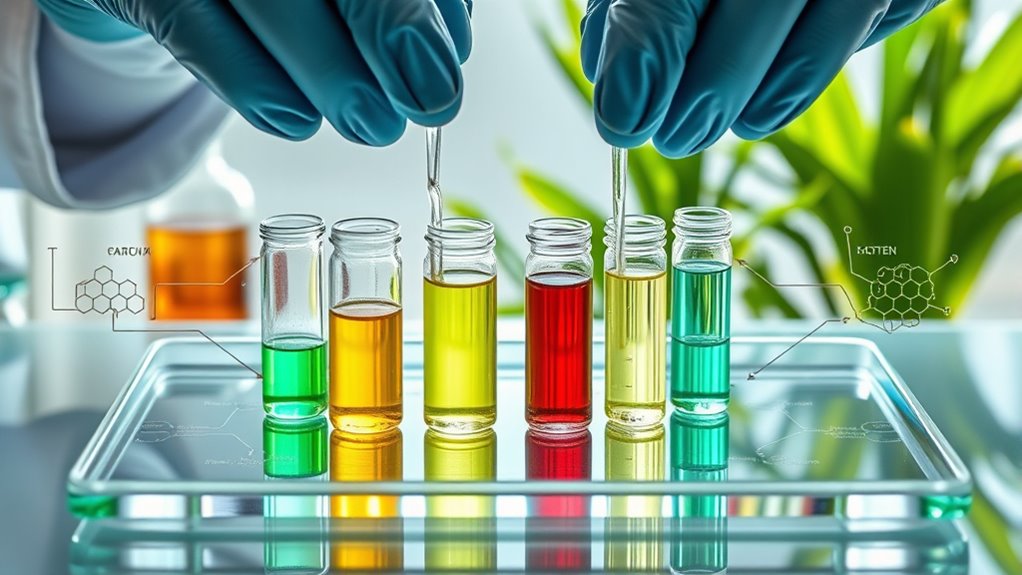
Designing safer chemicals focuses on maintaining their intended functions while considerably reducing their toxicity and environmental impact. You aim to balance chemical effectiveness with safety for humans and the environment by shifting from hazard mitigation to toxicity prevention during the design process. This involves replacing carcinogenic or endocrine-disrupting groups, optimizing molecular structures to lower bioaccumulation, and prioritizing chemicals with higher toxicity thresholds. Computational modeling helps predict toxicity early in research, allowing you to eliminate reactive moieties that cause adverse effects. You also preserve key functions, such as binding affinity, stability, and physical properties, while redesigning chemicals. Modern approaches incorporate lifecycle analysis, bio-based feedstocks, and AI-driven design, all working together to create safer, effective chemicals that perform well without compromising safety or sustainability. Prevention can be integrated into the design process by proactively addressing potential hazards before synthesis begins. Additionally, understanding the resources available, such as regional legal expertise, can support compliance and safer chemical development.
Safer Solvents and Auxiliaries
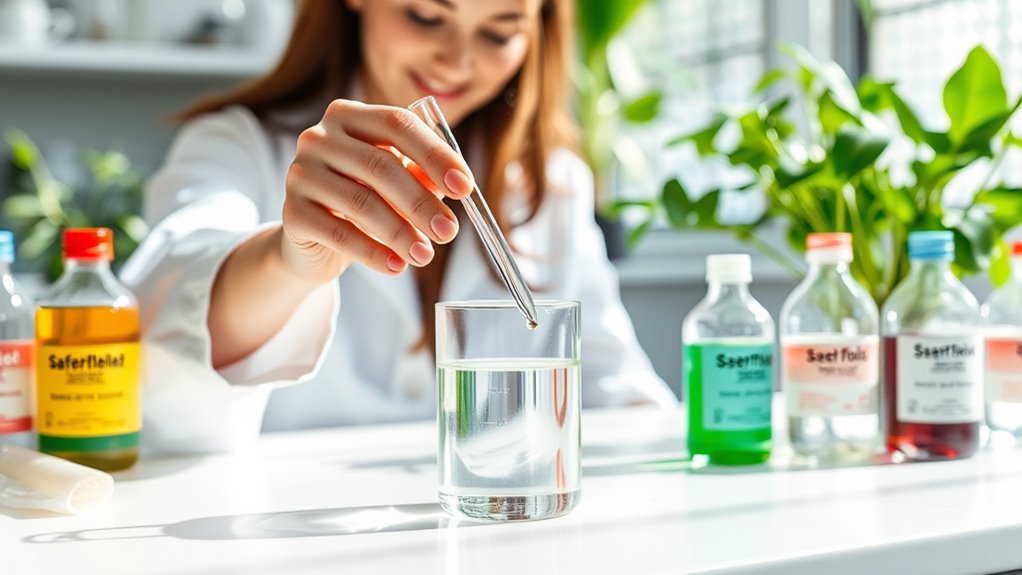
Have you ever considered how auxiliary substances like solvents impact both the environment and workplace safety? Solvents and other auxiliaries are essential for dissolving reagents, mixing components, and controlling reaction conditions, but they often generate significant waste and pose hazards. Principles of Green Chemistry focus on reducing or eliminating auxiliary substances such as solvents and separation agents to minimize environmental impact. Using safer auxiliaries means choosing non-toxic, environmentally benign options, which reduces waste and pollution. Strategies include replacing hazardous solvents with greener alternatives like water, ethanol, or bio-based solvents, and recycling solvents to minimize consumption. Optimizing reaction conditions can also limit solvent use altogether. For example, employing solvent-free techniques or alternative energy sources can substantially decrease solvent dependency. Examples such as switching from chlorinated solvents to less harmful polar aprotic solvents or employing micellar catalysis demonstrate practical improvements. These changes lower health risks, decrease disposal costs, and align processes with sustainability goals, making your chemistry safer and more environmentally responsible.
Design for Energy Efficiency
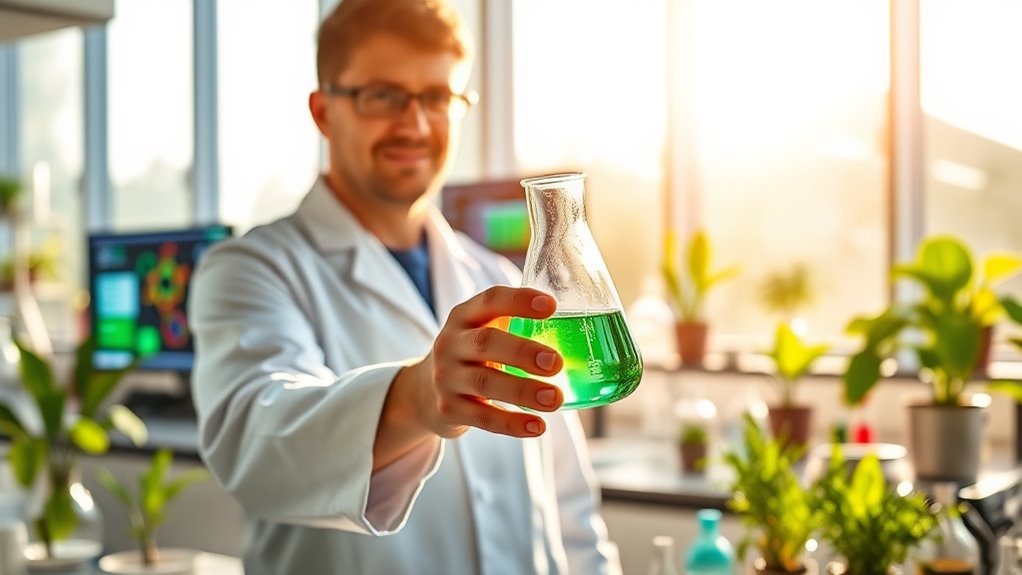
Ever wondered how you can reduce energy consumption in chemical processes? You can start by designing reactions to occur at ambient temperature and pressure, which cuts down on heating and cooling needs. Using alternative heating methods like microwave or ultrasound can further lower energy use. Incorporating sustainable materials such as recycled glass or bamboo in process equipment can also contribute to energy efficiency. Enzymatic and antibody-catalyzed reactions often proceed under mild conditions, saving energy while maintaining efficiency. Process intensification techniques, such as consolidating steps, reduce overall energy input. Optimizing reaction conditions—like lowering temperature and pressure, controlling reaction time, and choosing suitable solvents—also helps minimize energy waste. Additionally, adopting continuous flow techniques improves heat transfer efficiency versus batch processes.
Use of Renewable Feedstocks

Did you know that renewable feedstocks serve as sustainable alternatives to fossil resources in green chemistry? These include biomass from plants, algae, animal wastes, water, hydrogen, and even CO₂, which is gaining recognition as a reusable resource. Identifying spoilage in plant-based feedstocks is essential to ensure safety and quality before processing. Agricultural residues like manure and crop leftovers, along with processed crops such as corn starch and oilseeds, are converted in biorefineries into sugars, alcohols, biodiesel, and chemicals. Ideal renewable feedstocks should be safe, abundant, and easy to transform with minimal steps, ensuring high yields and atom economy. They support scalable production and are compatible with catalytic and bioprocess technologies. Using renewable feedstocks reduces reliance on fossil fuels, lowers greenhouse emissions, and helps create more sustainable chemical manufacturing processes.
Reduce Derivatives

Reducing derivatives in chemical synthesis is a key strategy for making processes more sustainable. By avoiding protection and deprotection steps, you cut down on reaction stages, reagents, and waste. Fewer steps mean less energy consumption and lower costs, while also minimizing hazardous waste. Incorporating best practices in vacuum technology can further improve process efficiency and safety. Eliminating unnecessary derivatization improves atom economy and supports regulatory compliance. Practical methods include direct functionalization, chemoselective catalysts, multifunctional reagents, and one-pot reactions that skip intermediate isolations. Although some molecules may require protection, innovative chemistry and strategic planning can often reduce or eliminate these steps. Emphasizing minimal derivatization not only streamlines synthesis but also enhances safety, reduces environmental impact, and promotes cost-effective manufacturing. This approach aligns with green chemistry‘s goal of more efficient, less wasteful chemical processes.
Catalysis

Why is catalysis considered a cornerstone of green chemistry? Because catalysts enable reactions to proceed faster, under milder conditions, and with less waste. They participate without being consumed, so you can reuse them repeatedly, reducing material needs and waste generation.
Catalysts also improve selectivity, producing fewer byproducts and simplifying purification. Using catalysts often means using smaller amounts of hazardous reagents, making processes safer and greener.
Furthermore, selecting the appropriate catalyst type—such as enzymes, heterogeneous, and metal-based catalysts—allows for tailored reaction conditions and outcomes. Key performance metrics—like selectivity, turnover frequency, and stability—help you assess efficiency and durability.
Design for Degradation
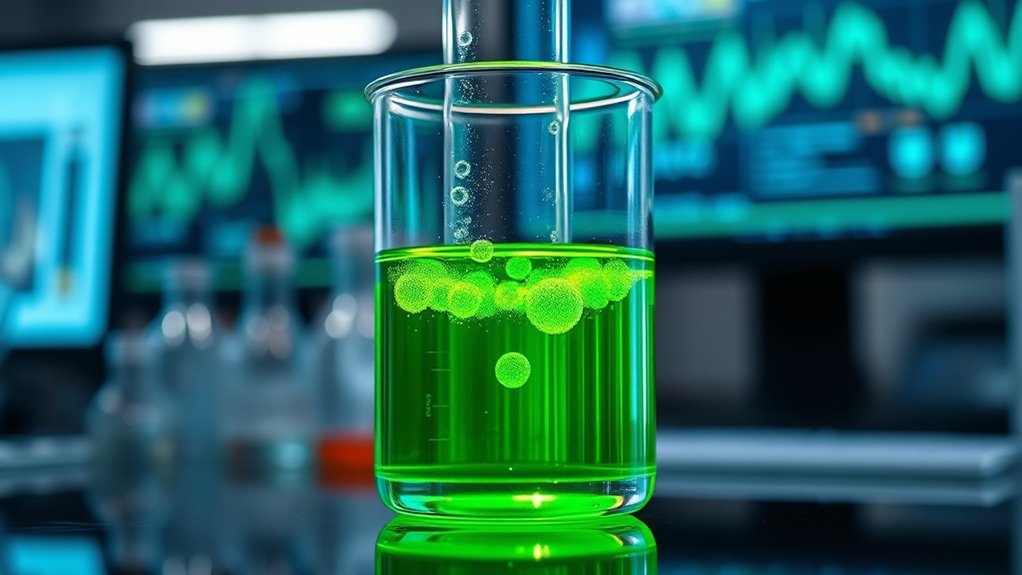
Building on the importance of designing efficient catalysts in green chemistry, creating products that break down safely after use is equally essential for minimizing environmental impact. When you design for degradation, you ensure chemical products decompose into harmless substances, reducing pollution and persistence in the environment.
For example, biodegradable plastics and linear soap isomers are easier to break down naturally. Focus on designing molecules that degrade swiftly under environmental conditions, using techniques like molecular structuring and enzymatic processes. Incorporating reliable headphone connections can also help reduce electronic waste by extending device lifespan.
Select materials that naturally biodegrade and consider the entire product lifecycle, from production to disposal. By doing so, you help prevent long-term accumulation of harmful substances, protecting ecosystems and human health.
This approach aligns with Green Chemistry Principle #10 and promotes safer, more sustainable products.
Real-time Analysis for Pollution Prevention

Have you ever considered how real-time analysis can transform pollution prevention in chemical processes? By continuously monitoring reactions, you can detect hazardous substances early and make immediate adjustments. This prevents the buildup of dangerous intermediates and reduces waste and emissions.
Advanced sensors, like spectroscopy and electrochemical tools, enable fast, in-process data collection. Integrating automation with process control allows quick responses to any anomalies, improving safety and efficiency.
Real-time analysis also helps ensure compliance with environmental regulations by controlling pollutants at the source. It supports green chemistry goals by optimizing reactant use and minimizing byproducts.
Minimize Potential for Accidents
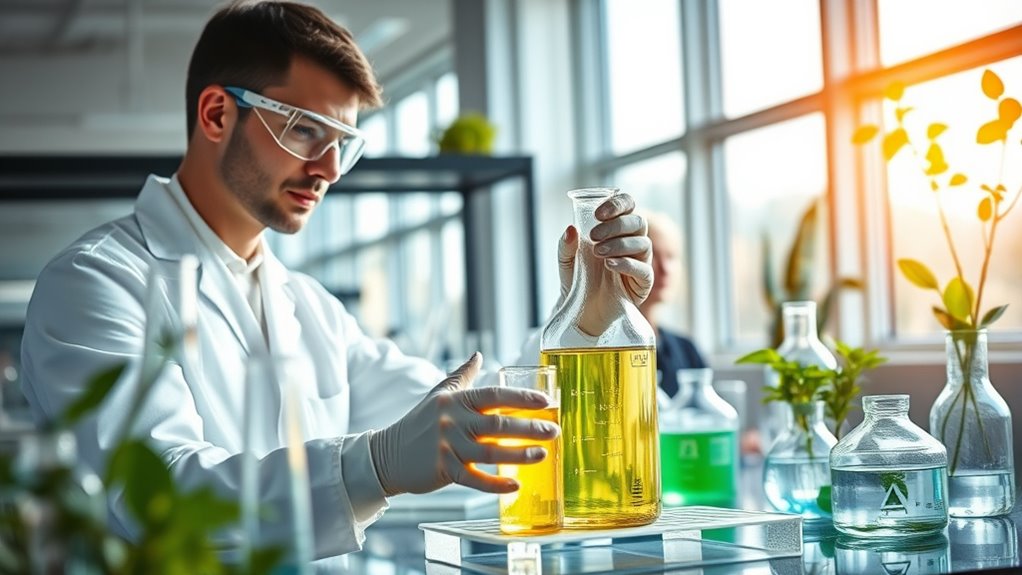
Designing chemicals with lower hazard potential is a crucial step in minimizing accidents in chemical processes. You should choose chemicals with low toxicity and environmentally friendly properties to reduce accident severity.
Selecting less volatile or reactive forms, like solids rather than gases, minimizes release risks. Avoid highly flammable, explosive, or reactive chemicals to lower fire and explosion hazards during handling and storage.
Using safer reagents and designing chemicals to degrade quickly after use diminishes environmental impacts if accidental releases occur. Controlling physical forms by immobilizing or encapsulating chemicals prevents unintended reactions.
Conduct reactions under mild conditions and avoid highly reactive reagents to reduce runaway reactions. Implement real-time monitoring, automated safety systems, and predictive models to detect hazards early.
Frequently Asked Questions
How Do Green Chemistry Principles Impact Cost Savings in Manufacturing?
You see, green chemistry principles help you cut costs by optimizing raw materials, reducing waste, and lowering energy use.
When you design processes to maximize atom economy and minimize derivatives, you spend less on raw materials and waste disposal.
Implementing energy-efficient methods and safer chemicals reduces utility bills and regulatory expenses.
What Are Common Challenges in Implementing Green Chemistry Practices?
When it comes to implementing green chemistry practices, you often face a mountain to climb. High upfront costs, uncertain ROI, and limited funding can feel like hitting a brick wall.
Regulatory uncertainties, technical hurdles, and organizational resistance also slow progress. You need patience and persistence to break through these barriers, foster collaboration, and embrace innovation—it’s a marathon, not a sprint.
Overcoming these challenges ultimately leads to sustainable, cost-effective solutions.
How Do Regulatory Frameworks Influence Green Chemistry Adoption?
Regulatory frameworks strongly influence green chemistry adoption by setting safety standards and restricting hazardous chemicals. You’re encouraged to develop safer alternatives and improve processes to meet these rules.
While regulations can drive innovation, they may also pose barriers due to complexity or lack of clear metrics. By fostering collaboration and offering incentives, regulations can accelerate green chemistry practices, making sustainable solutions more accessible and widely adopted across industries.
Can Green Chemistry Improve Product Performance and Durability?
Green chemistry can definitely boost your product’s performance and durability. By replacing toxic materials with safer alternatives, you enhance safety and reduce environmental impact.
Optimizing synthesis routes and using innovative technologies like nano-engineering further improve stability and lifespan.
Incorporating renewable feedstocks and recyclable catalysts guarantees consistent quality. These practices not only improve durability but also make your products safer, longer-lasting, and more sustainable.
Additionally, they often help cut costs and ensure compliance with regulations.
What Training Is Necessary for Chemists to Adopt Green Principles?
You’re beginning a journey into green chemistry, and the right training is your compass. Hands-on lab experience, online courses, and workshops act as your map, guiding you through sustainable techniques.
Mentorship and collaboration broaden your horizon, turning knowledge into action. By mastering these skills, you become a steward of innovation, transforming chemistry into a force that harmonizes with the environment, ensuring a greener, healthier future.
Conclusion
Remember, a journey of a thousand miles begins with a single step. By applying these green chemistry principles, you can make a real difference in reducing environmental impact and creating safer, more sustainable solutions. Embrace innovation and responsibility in your work, knowing that even small changes add up over time. Stay committed to greener practices, because when it comes to protecting our planet, every effort counts. Together, we can build a cleaner, healthier future.
